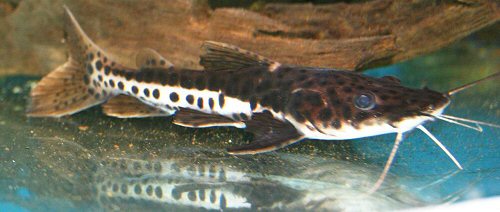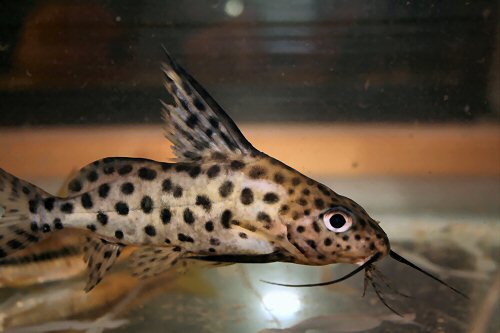SCOTCAT.COM
your internet guide to all things catfish
| Hybridized Fish. Are they ethical - Do we really need them? |
by Daphne Layley |
The above image, as far as we know, is a hybrid cross between Phractocephalus hemioliopterus (Red Tail Cat) and a Pseudoplatystoma species, possibly P. corruscans, but more than likely P. tigrinum
More recently, the local fish shops have been ‘flooded’ with Synodontis hybrids and these are so many and so varied that it’s sometimes difficult to distinguish between a true species and a cross, even to the experienced eye.
The above Synodontis sp. is sold in the aquatic outlets as S. pardalis but could be a S. occelifer/S eupterus cross although a S. nigrita influence may be a possibility too
The ultimate disgrace has to be the artificial cross between a Redtail Catfish and one of the largest members of a totally different and unrelated family, Pangasiidae – namely Pangasius sanitwongsei - a Paroon Shark, no less. I believe that this is absolutely disgusting – both these species grow huge – how large might such a hybrid grow – with the benefit of ‘hybrid vigour’ it could possibly reach a larger size than either parent!!! What will the owners do when it gets to four feet (120cm) long and it’s still growing fast? Maybe we already know the answer to that one..... All these species are magnificent fish in their own right, (even though some are too large for the average hobbyist). What motivates people to think that they can improve on nature? – they never will! It has to be for purely financial reasons although they may disguise it in the name of advancing scientific knowledge. What next I wonder – are they working on crossing an Angelfish with a Guppy even as I write? If someone crossed a cat with a dog, or a horse with a cow, or a parrot with an emu, all the animal welfare societies and animal rights activists throughout the world would be up in arms and there would be international condemnation. However, because fish aren’t warm and furry or cuddly, it apparently doesn’t matter. What would be the natural progression after that – humans crossed with Gorillas? Where will it all end? We should refuse to buy these fish, and we should make our feelings known to the shops that sell them! Image
Credits: Top:
Chris Ralph |
If you would like to contribute an article, please e-mail me. You will of course be credited for your work.
If you would like to donate any denomination of money to the site just click the above link button. All proceeds will go to running the site and hopefully to keep it going for a few years yet.
Print or e-mail this article below



